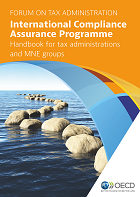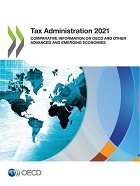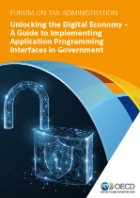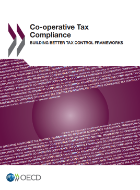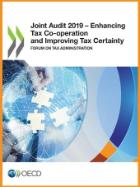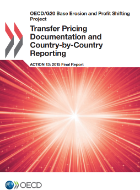Corporate income tax
Corporate income taxes (CIT) account for around 10% of total tax revenue (including social security contributions) collected across OECD countries and they often represent between 15 – 20% of total taxes in non-OECD countries.
CIT taxpayers are a very diverse group ranging from very largest multinational enterprises (MNEs) with sophisticated tax planning structures to very small businesses. This means that addressing the tax gap is a multifaceted challenge for tax administrations which are confronted with complex tax planning structures, the underreporting of income as well as unintentional errors. The latter can often be a result of complex corporate income tax systems that can be challenging and burdensome particularly for small business owners. At the same time, this complexity can also result in tax uncertainty for businesses as they may not fully understand their obligations or may be sometimes unsure as to how the tax administration will interpret tax provisions in particular contexts.
The issue of tax planning structures has been addressed through the OECD/G20 Base Erosion and Profit Shifting (BEPS) Project which looked at tax planning strategies used by some MNEs that seek to exploit gaps and mismatches in tax rules to avoid paying tax. Working together within the OECD/G20 Inclusive Framework on BEPS, over 140 countries and jurisdictions have been collaborating on the implementation of 15 measures to tackle tax avoidance, to improve the coherence of international tax rules and to ensure a more transparent tax environment. For more information on the BEPS Project, please visit the dedicated BEPS website.
In order to help address the issues that can lead to underreporting and unintentional errors, tax administrations and policy makers are:
- Increasing access to data for example through new electronic recording and/or reporting requirements on transactions, the sharing of data within government and internationally, as well as the collection of data directly from business systems and from publicly available sources.
- Enhancing risk assessment through the incorporation of a greater range of data sources and the use of new analytics tools including, in some cases, the use of artificial intelligence (AI).
- Improving online services to make it easier for taxpayers to understand their tax obligations, to interact with the tax administration and to report taxable income. This includes providing third parties with software that allows them to embed tax services and processes in the natural systems used by businesses.
- Improving tax certainty for example through rulings, cooperative compliance programmes and, at an international level, the OECD International Compliance Assurance Programme (ICAP).
Increasing access to data
As more and more data is generated, and the transfer, storage and integration of data has become easier through the application of new techniques and processes, there has been a significant increase in the use of data to support tax compliance. Amongst other things, this has been achieved through:
- New electronic recording and/or reporting requirements on transactions, such as the use of electronic cash registers and electronic invoicing systems (as described on the page on Value Added Tax [add link to the VAT page]).
- Connecting to taxpayers’ business systems: As taxpayers business administration systems become increasingly digitalised, tax administrations are increasingly exploring how they can digitally connect into the digital systems of taxpayers, whether that is into business software or into the electronic devices that taxpayers use as business tools.
- Collecting unstructured data concerning taxpayers: Increasingly electronic traces relevant to business activities and transactions can be found on the internet and in social media. Tax administrations collect this data, for example, to find unreported activities or unknown business connections.
- Using data from from other government agencies: Data held by other government agencies for example for licensing, regulatory or social security purposes can be relevant in verifying tax returns or in risk assessments.
- Using data from international partners: New international exchanges of data, such as the Country-by-Country Reporting, have increaed the quantity of data available on international activity, providing useful information for audit and case selection processes and in some cases for prefilling of tax returns.
While these approaches can help address non-compliance issues by making it easier to comply and harder not to comply, they can also be of great value for risk assessment purposes (see further below) and can facilitate the introduction of new services such as the prefilling of tax returns, something that a few tax administrations have started to consider for CIT purposes (see map below).
Data collection and prefilling of CIT returns
Note: To understand fully the information included in this map, users are advised to look at the source data tables and the original survey question as some of the self-reported data may not give the full picture and may need to be looked at in the wider context of the survey.
Enhancing risk assessment
Data that tax administrations receive, for example from electronic cash registers or e-invoicing systems, can be used to review taxpayer reported information through tax audits, automated electronic checks, validations (including customer validations) and the matching of taxpayer information. The undertaking and visibility of these and other compliance actions can play a significant role in supporting compliance, including through their impacts on perceptions of fairness in the tax system.
The increased availability of data also allows for a sharpened targeting of risks and as well as the analysis of emerging trends and, through the application of data science and advanced analytics techniques, can help to uncover patterns which may indicate non-compliance. For example, among other things, it is possible for algorithms to automatically compare the sales of businesses in the same sector and region and, where these fall outside of certain ranges, to trigger further investigations.
Risk assessment approaches
Note: To understand fully the information included in this map, users are advised to look at the source data tables and the original survey question as some of the self-reported data may not give the full picture and may need to be looked at in the wider context of the survey.
Click on Data Management for more information on how administrations manage their data, including data collection, data sharing and data analytics; or Tax Rule Management for how administrations use technology for tax rule management.
Improving online services
On a daily basis, tax administrations are communicating and interacting with businesses. The vast majority of those firms are small and medium-sized enterprises and, for many of those, dealing with tax obligations is a burdensome activity that often comes with uncertainty. To build a voluntary compliance culture among businesses it is important that tax administrations provide a wide range of effective and easy to use taxpayer communication and service channels, both on a reactive and proactive basis, as well as programmes to assist and educate business owners with meeting their tax obligations.
As regards communication, often these have been delivered on a one-to-many basis, such as the provision of guidance or reminders as well as calculation and reporting tools. However, the use of innovative tools allows communications to become more personalised to the business owners’ individual circumstances, to be delivered via an increasing range of communication channels and to facilitate the drive towards self-service.
With an increase in taxpayer expectations, the self-service offering from tax administrations is growing. Common examples of this include the ability to register, file and pay online, along with a range of interactive tools. This is leading to efficiency gains in tax administrations, as well as being able to provide a more 24/7-style service to taxpayers.
Corporate income tax: Online services provided by tax administrations
Note: To understand fully the information included in this map, users are advised to look at the source data tables and the original survey question as some of the self-reported data may not give the full picture and may need to be looked at in the wider context of the survey.
Source: Table TT2
While tax administrations are providing services through their own websites, a large number of administrations are also creating application programming interfaces (APIs) which allow connectivity between systems, people and things without providing direct access to tax administration internal systems. As well as using them in their own applications, many tax administrations are also making those APIs available to third party software developers allowing them to develop new applications and, in some cases, to embed tax services and processes in the natural systems used by businesses. The use of APIs in this way can help to improve tax compliance while also reducing administrative burdens on taxpayers. The map below shows for which type of CIT interactions tax administrations have published APIs. For more about the provision of online services by tax administrations, the (co-)creation of software packages or the development of application programming interfaces (APIs), visit: Taxpayer touchpoints
Corporate income tax: Interactions for which administrations have published APIs
Note: To understand fully the information included in this map, users are advised to look at the source data tables and the original survey question as some of the self-reported data may not give the full picture and may need to be looked at in the wider context of the survey.
Source: Table TT9
To allow the secure identification of taxpayers when interacting with the tax administration through digital means, tax administrations started creating unique digital identities of taxpayers. This allows taxpayers to access a range of digital services, for example, through taxpayer portals. The map below shows the usage of digital identities by business taxpayers to access secure digital services offered by tax administrations. Visit the Digital Identity page for more information on the use of digital identities by tax administrations, including the characteristics, authentication and authorisation processes.
Percentage of business taxpayers that use an approved digital identity to access secure digital services offered by the tax administration
Note: To understand fully the information included in this map, users are advised to look at the source data tables and the original survey question as some of the self-reported data may not give the full picture and may need to be looked at in the wider context of the survey.
Source: Tables DI2
Improving tax certainty
Rulings
As part of tax administrations’ commitment to give taxpayers certainty of treatment, it is now common practice for administrations to set out how they will interpret the laws they administer, and how they will interpret the tax law in particular situations, through rulings. Tax administrations may do this through:
- A public ruling which is a published statement of how an administration will interpret provisions of the tax law in particular situations. They are generally published to clarify application of the law, especially where a large number of taxpayers may be impacted by particular provisions and/or where a provision has caused confusion or uncertainty. Typically, a public ruling is binding on the tax administration if the ruling applies to the taxpayer and the taxpayer relies upon it.
- A private ruling relates to a specific request from a taxpayer (or their tax representative) seeking greater certainty as to how the law would be applied by the tax administration in relation to a proposed or completed transaction(s). The objective of private rulings is to provide additional support and certainty to taxpayers on the tax consequences of more complex transactions.
Click here to see more information about tax administrations’ approaches to rulings.
Co-operative compliance programmes
Over the last few years, there has been an increasing focus on the use of co-operative arrangements to manage compliance and enhance tax certainty. These programmes often involve a more transparent relationship between the tax administration and taxpayer, and can involve more proactive approaches to resolving material tax risks. The concept of co‑operative compliance has been the subject of several OECD reports, most recently Co‑operative Tax Compliance: Building Better Tax Control Frameworks. As the operation of a co‑operative compliance programme is resource intensive due to the high level of engagement between tax administration officials and taxpayers, traditionally, those programmes were reserved for large companies. However, technological advancements in risk assessment processes have led to a number of administrations applying this concept to other taxpayer groups. Click here to see who has co-operative compliance approaches.
International Compliance Assurance Programme
The International Compliance Assurance Programme (ICAP) is a voluntary programme for a multilateral co-operative risk assessment and assurance process. It is designed to provide multinational enterprise groups (MNE groups) with increased tax certainty with respect to certain of their activities and transactions as long as they are willing to engage actively, openly and in a fully transparent manner. ICAP does not provide an MNE group with the legal certainty that may be achieved, for example, through an advance pricing arrangement (APA). However, it does give assurance when tax administrations participating in an MNE group’s risk assessment consider covered risks to be low risk. See here for more information on ICAP.
Joint audits
The OECD report Joint Audit 2019 – Enhancing Tax Co-operation and Improving Tax Certainty describes another tool that can assist in improving tax certainty. In a joint audit officials from two or more administrations join to form a single audit team which will examine issues or transactions of a taxpayer with cross-border business activities and in which the jurisdictions have a common or complementary interest. By collaborating it may be possible for the participating tax administrations to detect and address differences or potential disputes at an early stage, thus providing certainty at an earlier stage.
Further information
Related Documents


